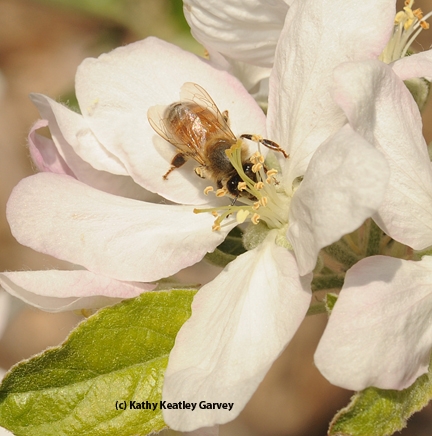- Author: Kathy Keatley Garvey
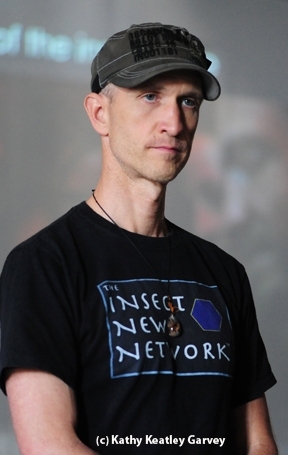
Cultural entomologist Emmet Brady, host of the Insect News Network, a Davis-based program on radio station KDRT 95.7 FM, is planning something special on Friday, Nov. 14 in Nevada City and you're all invited.
It's called "Cross Pollination: a Microcosmic Journey and it's a live filming segment on the art and the science of the microcosm, complete with decor, multimedia projections, interactive installations and costumes-- to showcase what Brady calls "the amazing designs, habits and beauty of insects, spiders and flowers."
Folks are invited to dress as their favorite insect, spider or flower to celebrate a gathering of the insect tribe.
The event footage will then be webcast in January for the Bee-A-Thon 4, an annual event to raise awareness about honey bees, pollinators and the importance of the microcosm.
The event will take place from 7 p.m. to 2 a.m. in the Miners' Foundry Cultural Center, 325 Spring St., Nevada City. For more information, access the specially created Facebook page.
Brady says Love and Light, Pega5u5 (Mr. Rogers and Pharroh), Ra So, Sambadrop, and Eminent Bee will be among the entertainers, with microscopic visuals by Sonik Galixsee.
If you dressed up as an insect, spider or flower costume for Halloween, no problem. You can resurrect your costume.
Or just create something special. Expand on the idea of butterfly wings worn by UC Davis entomology graduate student Christine Melvin at the Bohart Museum of Entomology. The wings were a popular attraction last month as visitors to the UC Davis insect museum tried on the wings and pretended to be monarchs on their migration to overwintering sites along coastal California and in central Mexico.
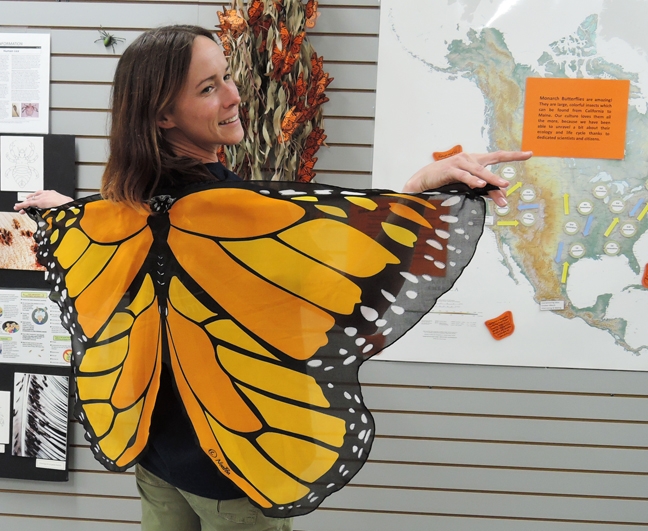
- Author: Kathy Keatley Garvey

"He did," said cultural entomologist Emmet Brady, host of the Insect News Network.
The occasion: a UC Davis dinner honoring Berenbaum, professor and head of the Department of Entomology, University of Illinois at Urbana-Champaign. Berenbaum had just finished speaking at the UC Davis Conference Center on the honey bee crisis and the next day would deliver a talk on "Sex and the Single Parsnip."
At the dinner, Brady gifted Berenbaum with an Insect News Network t-shirt. He hosts the popular show on the Davis radio station, KDRT 95.7 FM.
The conversation, however, soon turned to the lettering on the back: "I am dying by inches from not having anybody to talk to about insects..."--Charles Darwin, 1828.
Did he say that?
Yes, he did.
In a letter penned June 12, 1828 to his second cousin, clergyman William Darwin Fox (1805-80), Charles complained he had no one to talk to about insects. He started the letter with "My dear Fox." Not "Will" or "Willy" or "William" or "Cuz" but "My dear Fox."
The "I-am-dying-by-inches" quote followed.
In reality, many entomologists feel the same way. Not because they have no one to talk to, but many folks don't listen. Here they are enthusiastically talking about the biology of their favorite insect only to see their "listeners" stifling a yawn, picking imaginary lint off a sleeve, gazing at their watch, or nowadays, checking their cell phone for messages.
Well, doesn't everyone have a favorite insect? And shouldn't everyone be interested in the biology and life cycle of the long-nosed bee fly, the salt marsh tiger beetle, the Madagascar sunset moth and other critters?
Emmet Brady yearns to get people talking about insects. He hosts a show from 4 to 5 p.m. Wednesdays and from noon to 1 p.m. on Fridays. (You can also listen online.) In addition, Brady hosts the Bee-A-Thon, a global online marathon dedicated to raising awareness about honey bees and other pollinators. He also sponsors a "Bug of the Year" contest, urging people to vote for their favorite bug. (This year the long-nosed bee fly won a hair.)
Brady works closely with the UC Davis Art/Science Fusion Program, co-founded and co-directed by entomologist/artist Diane Ulllman and self-described "rock artist" Donna Billick. He's presented such talks as "Insects Run the Planet—Humans Are Only Along for the Ride" and "Cultural Entomology: A New Horizon for the Arts and Sciences."
As for May Berenbaum, she's an icon in the entomological world and will serve as president of the 7000-member Entomological Society of America in 2016. She's a a talented scientist, dedicated researcher, dynamic speaker, creative author, and an insect ambassador who wants people to overcome their fear of insects.
And now, the proud owner of a t-shirt calling attention to her favorite subject: insects.



- Author: Kathy Keatley Garvey
If you're wondering which bug won "Bug of the Year" in Emmet Brady's Insect News Network (INN) radio poll, it's not the honey bee.
But there is a "bee" in its name. It's the "long-nosed bee fly."
I once captured an image of that curious critter in the Storer Garden, UC Davis Arboretum (see below)
"This nominee is a personal favorite of the team @ The INN for it is bodacious!," Brady wrote on the INN website. He broadcasts INN on Wednesdays from 4 to 5 p.m. and Fridays from noon to 1 on KDRT 95.7 FM, Davis. You can also listen online.
"Long-nosed bee flies (Bombylius major) stay low to the ground are highly territorial and are easy to track," Brady wrote. "Unlike the majority of glyciphagous dipterans, the bee flies feed on pollen (from which they meet their protein requirements). A similar trophic behavior occurs among the hover flies, another important family of Diptera pollinators.
"Watching these flies argue over a flower or a patch of plants is pure enjoyment for the whole family. While the Bombyliidae include a large number of species in great variety, most species do not often appear in abundance, and for its size this is one of the most poorly known families of insects. There are at least 4,500 described species, and certainly thousands yet to be described. So if you pay attention and plant the right flowers, you may be able to create a Citizen Science project that is a little Hollywood and a little Natural History Museum. You might even discover a new species, and then you can name it whatever you want!"
The first runner-up? The honey bee. Interesting that the long-nosed bee fly and the honey bee were "neck and neck" for awhile.
Brady is delighted that the bee fly won because it's a fairly unknown and unusual bug--a bugs that doesn't get much attention.
As for the honey bee, it's "the perennial candidate for the Bug of the Year (BOTY)," Brady says, acknowledging that the honey bee "perhaps the most important insect to human civilization."
So, bee fly, first. Honey bee, second.
Here's the top 10:
1. Long-Nosed Bee Fly
2. Honey bee
3. Kirk Jellum’s Praying Mantis Sculpture from Burning Man
4. The Monarch Butterfly
5. Madagascar Sunset Moth
6. Ogre-Faced Spider
7. Elephant Hawk-Moth Caterpillar
8. Mirror Spider
9. Salt Marsh Tiger Beetles
10. Orchid Bee
You know which of the 25 nominees for Bug of the Year came in dead last?
The mosquito! It's "not last but not least..." It's "last and definitely least."
Nobody likes the mosquito.

- Author: Kathy Keatley Garvey
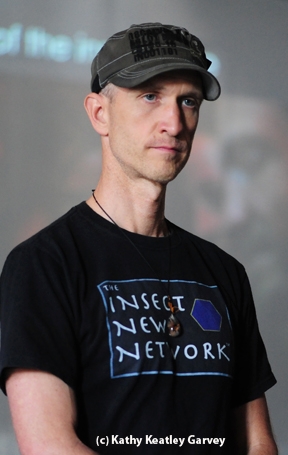
Inquiring minds want to know.
At least one inquiring mind wants to know.
Journalist/cultural entomologist Emmet Brady of Davis, who reaches out to bug and non-bug people alike on his Davis-based radio show, "Insect News Network," is hosting his annual Bug-of-the-Year contest through Jan. 14. You can hear his show Wednesdays from 4-5 p.m. and Fridays from 12 p.m. to 1 p.m. on KDRT 95.7 FM, Davis.
Last year the Australian Peacock Spider won Brady's contest. A spider? That's perfectly fine. Spiders are not insects but they fit quit well into the "Bug of the Year" candidates. And, they have excellent credentials.
And speaking of peacock spiders, you should check out Gwen Pearson's blog on Charismatic Minifauna: New Species of Peacock Spider Dances for You--and Sex and watch the video of this fascinating spider. Pearson, who holds a doctorate in entomology, initially began blogging as "The Bug Girl."
Emmet Brady urges everyone to vote, and vote often. Access the vote page here. "You can vote as many times as you like, for as many bugs as you like," Brady says, "but only one per visit, however."
And the 25 contenders? Drum roll, please:
- Yellow-Headed Soldier Fly
- Green Lynx Spider
- Monarch Butterfly
- Oregon Yellow-Faced Bumble Bee
- Madagascar Sunset Moth
- Salt Marsh Tiger Beetles in Love
- Variegated Meadowhawk Dragonfly
- Orchid Bee
- Tizsa Flower Mayflies
- Golden Spotted Oak Borer
- Long-nosed Fly
- Robobees
- Praying Mantis Sculpture
- Ogre-Faced Spider
- Honey Bee
- Magicicada
- GM Mosquito
- Asian Citrus Psyllid
- T Mirror Spider
- Himalayan Spider
- Brown Marmorated Stink Bug
- The Map Butterfly
- Ant-Mimick Tree Hopper
- Bird-Dropping Spider
- Elephant Hawk-Moth Caterpillar
Brady kindly lists their qualifications. For example, he writes about the honey bee:
"The perennial candidate for the BOTY, the honey bee is perhaps the most important insect to human civilization. They represent in many ways a pinnacle of invertebrate evolution, as well as a complex and mystical interdependence with humans. The bee has significance in almost every facet of our existence: ecological, economic, spiritual, historical, psychological, artistic, biomimetic and sociological. Honey bees belong to the genus Apis, with 7 species worldwide. There were no 'true' honey bees in the Western Hemisphere until the 17th century. They embody a omnipresent contradiction in modern ecology: today, there are more honey bees on the planet than at any time in history. However, the use of bees as agricultural tools has led to mismanagement and disrespect, as their commercial numbers have plummeted as much as 60 percent in the past 20 years."
If none of these bugs is for you, wait--there's another one. It's called "other."
Just type in your favorite. Either way, this bug's for you.

- Author: Kathy Keatley Garvey
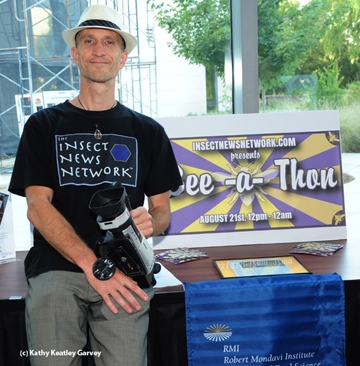
Brady, a cultural entomologist, hosts the Insect News Network on KDRT 97.4 FM Radio, Davis, and every year he hosts a "Bee-a-Thon" to spotlight honey bees.
So, get ready for Bee-a-Thon 3!
The free multimedia event will begin online with a series of videos about honey bees and other members of the Microcosm, including videos created by Brady and clips from previous Bee-a-Thons.
UC Davis will be represented by Eric Mussen, Extension apiculturist with the UC Davis Department of Entomology and Nematology; and entomologist/artist Diane Ullman and artist Donna Billick, co-founders and co-directors of the UC Davis Art/Science Fusion Program. Mussen, a member of the department since 1976, is world-renowned for his honey bee expertise. Ullman is the associate dean of undergraduate academic programs in the UC Davis College of Agricultural and Environmental Sciences and a professor of entomology.

Among the others to be interviewed will be Kim Flottum, longtime editor of Bee Culture magazine; Ria de Grassi, director of federal policy, California Farm Bureau; Eddie Dunbar, founder of the Insect Sciences Museum of California; Celeste Ets-Hokin, creator of the Pollinator Gardens at Lake Merritt, Oakland; and Mike Somers, state director of Pesticide Watch and the Pesticide Watch Education Fund.
The schedule includes:
- a pollination fundraising luncheon, with a honey-inspired menu, from noon to 1 p.m. at Monticello Seasonal Cuisine, 630 G St. (not broadcast).
- fruit presentations from 1 to 1:30 p.m. at the Davis Food Co-Op, 620 G St.; (not broadcast)
- a live broadcast from 2 to 4 p.m. on Davis Community Television public access Channel 15
- a radio/video feed from KDRT, 95.7 FM, from 4 to 6 p.m.
- BATMAP (Bee-a-Thon Monster After Party) billed as the world’s first Pollinator Party from 7 to 10 p.m. at the Davis Media Access, 1623 Fifth St., and featuring music by Eminent Bee. Admission is free, but guests must come adorned as an insect, spider or flower.
- a lounge chat from 10 p.m. to midnight at deVere’s Irish Pub, 217 E St.
We've posted several photos and the schedule on the UC Davis Department of Entomology and Nematology website. Be sure to check out the Insect News Network website for more information.
Brady says the art-science event is designed to ignite a community about the full story about honey bees and other pollinators — "not just the science, but the art, the anthropology, the technology and design, the pop culture."
“The interdependence we have with insects — especially bees — is profound and complex and most people are only discussing half the story," said Brady, who holds a bachelor’s degree in biology from Hiram (Ohio) College. "The key word is biocomplexity — how human behavior fits into the global ecology. It’s also about how insects inspire and amaze our society. That will all be covered on the show.”
Brady described the Bee-a-Thon as timely; Time magazine just published a cover story on “beepocalpyse.”
We know Emmet Brady to be passionate about honey bees. And we know that the Bee-a-Thon will be educational, informative and entertaining.
When Brady talks about the "wonderful world of pollinators," he's thinking of the simple things we take for granted, the ABCs, if you will.
A honey bee on an Apple.
A honey bee on a Begonia.
A honey bee on a Cucumber.
